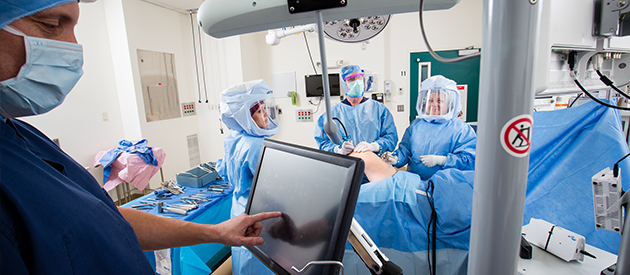Partial Knee Replacement
The partial knee replacement surgical procedure allows your surgeon to access, remove and accurately replace only the damaged surface of your knee – leaving your healthy bone intact. Below is a brief description of the procedure:
- An incision is made to expose the damaged joint
- For a Uni knee implant, the end of the femur and top of the tibia are shaped to accommodate the Uni implant components
- For a PFJ implant, only the front surface of the femur is shaped to accommodate the PFJ implant component
- Trial components are placed to ensure proper alignment
- Once properly aligned, the trial components are removed
- The final implant components are implanted
- The incision is closed
Post-Operative Protocol
After leaving the operating room, you will most likely be transported to a recovery area where you will be closely monitored before returning to your room. Once you have returned to your room and your surgeon has given approval, you may begin the post-operative rehabilitation process. Your surgeon may recommend the following to begin rehabilitation while you are still in the surgical facility:
Ice and elevation to reduce pain and swelling in your knee
Walking with a walker or crutches
What to Expect
On average, this type of surgery takes approximately one to three hours, depending on your individual circumstances.
Usually you’ll be ready to return to your room after one to three hours in recovery.
After surgery, your pain may be managed via intravenous therapy and/or a pain pump and/or injection and/or pills given by mouth.
Depending on your situation, you may be able to walk with the aid of a walker or cane.
It is normal for your joint to remain warm, swollen and slightly tender for a number of weeks. Call your doctor immediately, however, if you notice:
- Increased pain, redness or swelling
- Incision drainage
- Prolonged nausea or vomiting
- Chest pain or shortness of breath
- Tenderness in the calf or thigh of the operated leg
- A fever
Most patients are ready to drive a car about eight weeks after surgery, but not unless your surgeon authorizes it.
Recovery varies greatly based on individual factors but most patients resume normal activities in about 12 weeks following surgery.
Knee Anatomy: Only Replace What is Damaged

The knee joint is the point at which the femur bone of the thigh meets the tibia bone of the lower leg. All the components of the knee – bones, cartilage, synovial membrane, ligaments, tendons and muscles – must work together properly for the knee to move smoothly.
Cartilage is a protective cushioning that keeps the bones from rubbing against one another. In a healthy knee, a thin, smooth tissue liner called the synovial membrane releases a fluid that lubricates the knee, reducing friction as the bones move. In an arthritic knee, the cartilage between the femur (thigh bone) and the tibia (shin bone) gets worn away, causing the two bones to scrape against each other. When this happens, the joint can become pitted, eroded and uneven, often resulting in pain, stiffness and instability. While this type of arthritis damage often happens throughout the entire joint, for some patients it can be localized in a single compartment of the knee. If the damage is localized to a single compartment, treatment with partial knee replacement may be an option. Because partial knee implants only replace the damaged bone and cartilage of the medial, lateral or patellofemoral compartment of your knee, the rest of your natural knee’s structure is retained.
